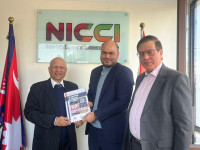Money
FDI pledges drop amid unstable polity, economic slowdown
Though Nepal’s BB- rating is being celebrated, says an expert, foreign investors will struggle under this category.
Krishana Prasain
Nepal’s foreign direct investment commitment declined by 4.54 percent in the first four months of the current fiscal year until mid-November. The country’s power struggle continues to dampen investment and development for the country aspiring to graduate from the ranks of least developed countries in 2026.
According to UN Trade and Development (UNCTAD), the UN institution dealing with trade and development globally, the decrease was primarily due to rising geopolitical tensions and concerns over “greenwashing”, a marketing practice to make things seem more environmentally friendly than they actually are.
In Nepal, insiders say, an unstable political system that results in instability in critical policies is the main reason behind low FDI. Fitch, a credit ratings agency, concurs.
According to the Department of Industry statistics, Nepal received investment pledges for Rs17.64 billion in 163 projects in the review period, which promises to generate employment for 8,180 people.
“Recently, Nepal got a country credit rating of BB-, and everyone seems happy. But Nepal got BB- in non-investment grade, which means the country is not investment friendly and nor has there been an improvement in its business climate,” said Nara Bahadur Thapa, former executive director of the Nepal Rastra Bank.
On November 21, Fitch Ratings assigned Nepal a long-term foreign-currency Issuer Default Rating (IDR) of 'BB-' with a stable outlook. The ratings reflect Nepal’s low and highly concessional government and external debt burdens, strong external liquidity and solid growth prospects underpinned by the hydropower sector.
“Nepal got the BB- rating only because the foreign exchange reserve is in surplus, which will help in the repatriation of profit of foreign investors,” said Thapa.
According to Fitch’s rating action commentary, Nepal has little external borrowing outside the public sector, reflecting its minimal foreign direct investment and limited integration into the global financial system.
It said that burdensome procedures on profit repatriation and other regulations on external transactions have historically significantly constrained FDI inflows—but the authorities are addressing this.
Fitch said frequent leadership changes in Nepal, eight changes of government since the beginning of 2014, with recurrent power struggles and shifting political alliances, have been undermining long-term policymaking and development planning.
It warns that medium-term growth prospects weakened materially, for example, due to challenges in implementing development projects amid political instability, which could lead to negative rating action or downgrade.
But there is a silver lining. Stable economic growth enables substantial increases in GDP per capita, potentially supported by improved governance standards and regulations conducive to private and foreign investments.
“The country ceiling for Nepal is 'BB-', in line with the Long-Term Foreign-Currency IDR. This reflects no material constraints and incentives, relative to the IDR, against capital or exchange controls being imposed that would prevent or significantly impede the private sector from converting local currency into foreign currency and transferring the proceeds to non-resident creditors to service debt payments,” according to Fitch.
“With a BB- rating, a narrative has been set that now is a good time to invest. But under this category, foreign investors will struggle here,” said Thapa.
There are two grades in sovereign country rating. One is investment grade, and another is non-investment grade.
A high-level economic reform committee has been formed, and it needs to look into improving the indicators listed for ease of doing business and gaining a BB status, said Thapa.
In the first four months of the current fiscal year, investment commitments have mainly come for small-scale industries.
The department received investment commitments of Rs13.17 billion for 159 projects, Rs275 million for a medium-scale project and Rs4.20 billion for three large-scale projects.
The highest FDI commitment has come in the tourism sector, amounting to Rs11.58 billion for 119 projects.
Similarly, Rs3.90 billion has been pledged for 21 service sector projects, Rs1.36 billion for 14 manufacturing projects, Rs600 million for three agro and forestry projects, and Rs174 million for five information and communication-based sector projects.
The country received a commitment of Rs20 million for one mineral project.
In the review period, the industry department recommended business visas for 900 investors, their 153 representatives, and 295 dependents.
According to Nepal Rastra Bank, the country received net foreign direct investment of Rs4.81 billion in the first three months of the current fiscal year, which ended in mid-October.
There is a significant gap between approved FDI and actual net FDI inflows into Nepal.
Investment summits are held, and pledges made but they are not realised.
Nepal needs to improve in 10 indicators of Doing Business, which used to be published by the World Bank but have now been discontinued.
“There is a huge problem with tax payment in Nepal; it is filled with hassles. There are problems with company registration. There is no improvement in getting electricity and bank loans as there is no project loan service and a huge problem in repatriation. There have been no improvements on these indicators,” said Thapa.
India tried to improve the FDI climate in line with Doing Business indicators, including an economy survey and budget. However, Nepal has not chosen a path for improvement.
In the last fiscal year alone, only 13.57 percent of the committed Rs61.90 billion was realised, with actual foreign investment amounting to Rs8.40 billion.
According to a report of Nepal Rastra Bank, between fiscal year 2014-15 and the last fiscal year, although substantial foreign investment commitments were made, a significant portion failed to enter the country.
The trend shows that while foreign investment commitments have been increasing, the inflow of funds remains relatively low. Industry experts point out that no regulatory requirement mandates that all committed investments must be realised within the same fiscal period.
The report said that the government allows investors to bring in funds in phases, contributing to the gap between commitment and realisation.
During the third edition of the Nepal Investment Summit, which was held on April 28, the Department of Industry launched an automated route allowing foreign investors in Nepal to invest in sectors without requiring prior approval from other government authorities.
The government adopted more flexible policies starting in fiscal year 2022–23 to address the shrinking FDI inflows. The minimum threshold for FDI was reduced from Rs50 million to Rs20 million in the fiscal year 2023-24. Additionally, new plans were announced to review sector-specific minimum investment requirements.
The budget also mentions removing investment limits for the information technology sector, although the specifics are yet to be finalised, the central bank report said.
But there is no improvement in the FDI flow.
In the fiscal year 2021-22, a commitment of Rs54.15 billion was made for 295 industries, but the net FDI inflow was just Rs18.56 billion.




 17.12°C Kathmandu
17.12°C Kathmandu













